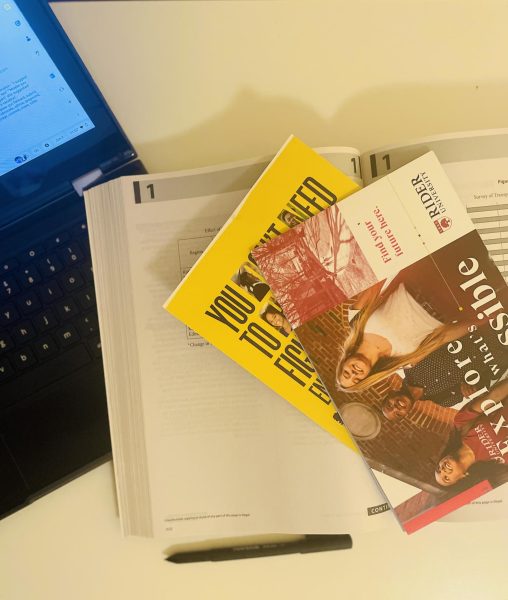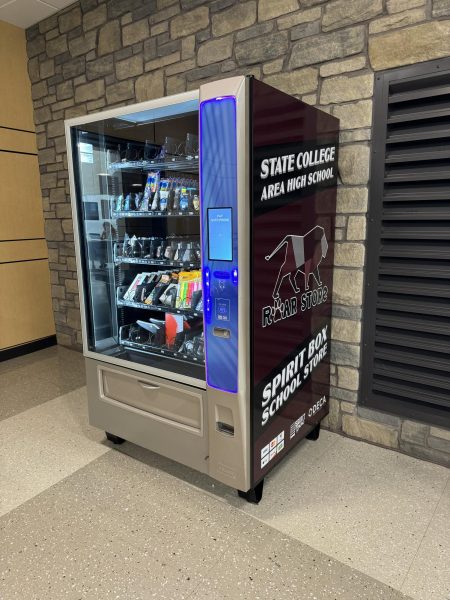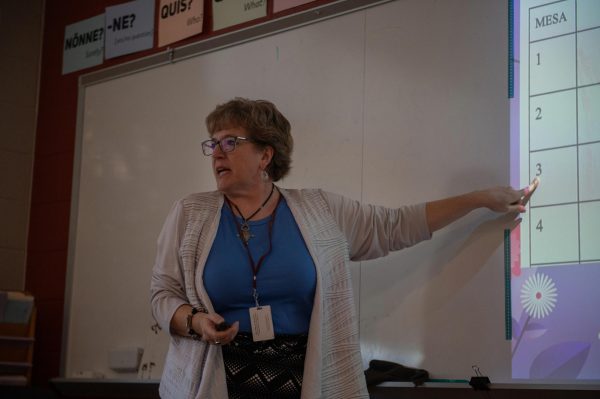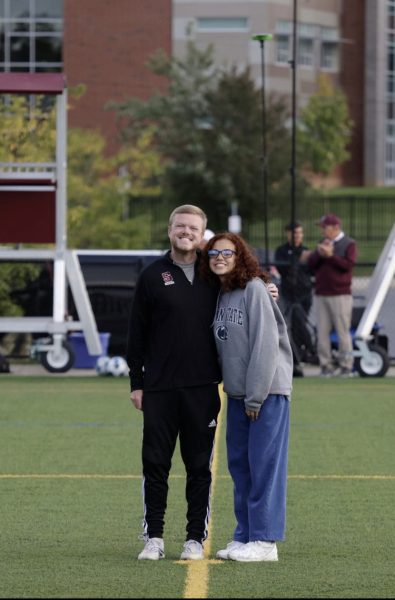The Unknown Adversities Behind Type 1 Diabetes
Type 1 diabetic, Emma Barlett, is a junior at State High and has been living with T1D for twelve years. Barlett plays on State High’s field hockey team, where she often deals with fluctuations in her blood sugar. She compares these feelings to a migraine or sports injury, something that lasts for days. “The impact of these fluctuations can affect how you are performing in a sport,” Barlett said. Pictured on her right arm is Barlett’s Omnipod, which delivers insulin to her body when her blood sugar is high.
October 27, 2020
As National Diabetes Awareness Month approaches this November, millions of people across the world are coming together to bring awareness to the disease that they are living with. For me, this is a cause close to my heart, as the most important person in my life has been affected by this disease.
My personal experience started at six years old, when my mother was diagnosed with type 1 diabetes. I quickly learned to understand the severity of diabetes, as I witnessed the struggles my mother experienced every day.
Some of the difficulties that my mom has had to adapt to consist of constantly checking blood sugar and dealing with the effects of high and low blood sugar, such as fatigue, anxiety, and frustration.
Misconceptions about type 1 diabetes come from a lack of awareness and understanding of the disease. While some believe that type 1 diabetes is caused because a person is overweight or lives an unhealthy lifestyle, the truth about the disease is far from that. Type 1 diabetes presents itself when the body’s immune system destroys the cells in the pancreas, halting the production of the important hormone known as insulin. Type 2 diabetes is caused when the body becomes resistant to insulin, typically occurring when someone is living an unhealthy and inactive lifestyle. Insulin helps to maintain a normal blood sugar (glucose) level in the body helping the cells to use the glucose. When insulin is not being produced by the pancreas, blood sugar levels rise causing symptoms in the body such as dehydration, weight loss, diabetic ketoacidosis, and other damage to the body, according to WebMD. After a person is diagnosed with type 1 diabetes, they are forced to put insulin into their body through an injection or a pump.
Nearly 64,000 people are diagnosed with type 1 diabetes every year. An estimated 1.6 million Americans are living with type 1, 200,000 of them younger than 20, according to the Juvenile Diabetes Research Foundation (JDRF). JDRF is the world’s largest nonprofit funder of type 1 diabetes research, focusing on advancements towards a cure for the disease.
With so many young people living with T1D, there are, in fact, several students at State High living with this disease. Emma Barlett, one of these students, a junior at State High, shares her story of diabetes. “I was diagnosed when I was four years old, December of 2008,” Barlett said. Prior to her diagnosis, Barlett recalls finding indications that something was off, such as a constant feeling of thirst.
Barlett also notes some of the challenges that type 1 diabetes has caused throughout her life. “Growing up, one of the hardest things for me was having to be around my friends who didn’t have to measure everything they ate, check their blood sugar, or give themselves insulin. It took a lot away from my childhood.” Being so young and dealing with so much, one can only imagine the difficulty it was to grow up with these continuous challenges.
“There are situations where it might look like I am aware and present, but I really have no idea what’s going on because of the internal adversities that my body is putting me through.” These difficulties typically come from a fluctuation in blood sugar levels in the body. Barlett describes the effects of high blood sugar as feelings of confusion and frustration.
While several difficulties come with living with T1D, Barlett has found a positive impact as well. “Diabetes has helped me adapt to change easier and mature quicker than other kids my age,” she said. She has also found several ways to advocate for type 1 diabetes, such as donating to JDRF and the American Diabetes Association. Barlett has also discovered a way to share her story with the world. “I write essays to the White House for the Juvenile Diabetes Congress, which brings representatives from each state who are juvenile diabetics to advocate for diabetes and what should be taught about it,” she said.
Another State High student, Anna Smithwick, has been living with type 1 diabetes for four years since she was diagnosed at the

age of 13. Smithwick says that some people believe that her disease is not a big deal. “In reality, it consumes 60% of my thoughts throughout the day,” she stated.
Smithwick shares that she struggles to get sleep some nights due to failures with her insulin pump.
“A lot of people think that I could have prevented this disease, which is not true. I wish people understood how hard it can be
some days,” Smithwick said. Some difficulties that type 1 diabetics deal with include constantly measuring blood sugar before eating and exercising.
Because of these misunderstandings, Smithwick has found ways to bring awareness to type 1 diabetes. “I love to talk to people about it and educate them, and my family also donates to JDRF. I have been to several walks in support of T1D,” she said. Smithwick hopes that bringing awareness to this subject will help people to understand the difficulties that come with living with type 1 diabetes.
State High sophomore Madison Fry is a type 1 diabetic and has been for four years. She learned of her diagnosis when visiting the doctor for another issue. Fry considers herself lucky that it was caught early instead of having to find out through a fatal accident, such as passing out.
Just like Smithwick and Barlett, Fry deals with constant fluctuations in her blood sugar. “When my blood sugar is high I get very fatigued and it’s hard for me to breathe. And when my blood sugar gets too low I feel shaky, dizzy, and weak,” she said. Fry notes that she fears getting low blood sugar when playing sports, so she does not take insulin before exercising. This often causes her blood sugar to rise.
Fry agrees that people should understand the differences between type 1 and type 2 diabetes. “I used to feel self-conscious about people knowing that I had diabetes because of the misconception that you get type 1 diabetes from being overweight,” she said. After researching type 1 diabetes, you will find that the disease is auto-immune and cannot be prevented. Fry added that many people don’t even know that there are multiple types of diabetes.
Type 1 diabetes is a serious disease that affects our friends, classmates, and community. I encourage everyone to learn more about the disease and how you can support those in our community living with T1D. To learn more and become involved, please visit JDRF and Beyond Type 1.













Jack Lyke • Nov 3, 2020 at 2:23 PM
As a T1D of 31 years I thank you for the article and appreciate the need to educate people about what it means to be T1D. Nicely done!
Joelle Bartlett • Nov 3, 2020 at 2:14 PM
Well done Hannah!
Shawna Mukavetz • Nov 3, 2020 at 12:05 PM
Excellent article!
Linda Bonness • Oct 31, 2020 at 8:28 AM
Great job Hannah! This is an important topic. I have two (now grown) nephews who have T1D and, although they’ve managed it, life with T1D is a challenge to say the least. Appreciate your work in helping educate people about it! Well done!